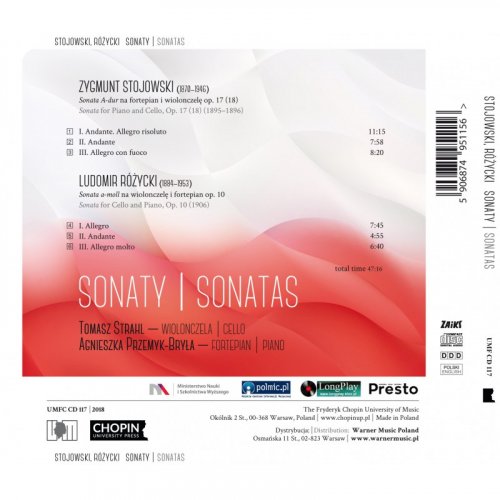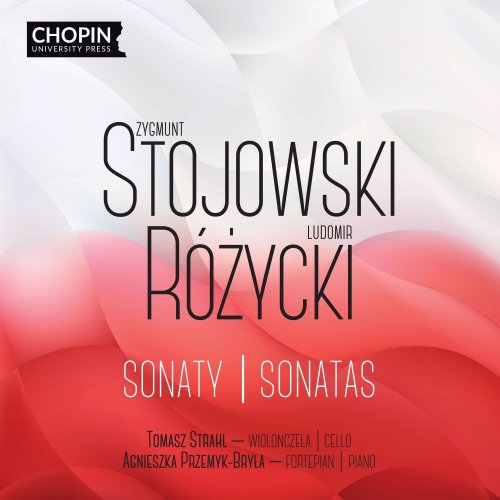
Chopin University Press - Stojowski, Różycki: Sonatas (2022)
BAND/ARTIST: Chopin University Press, Tomasz Strahl, Agnieszka Przemyk-Bryła
- Title: Stojowski, Różycki: Sonatas
- Year Of Release: 2022
- Label: Uniwersytet Muzyczny Fryderyka Chopina
- Genre: Classical
- Quality: FLAC (tracks)
- Total Time: 46:55 min
- Total Size: 193 MB
- WebSite: Album Preview

Tracklist:
1. Sonata for Piano and Cello, Op. 17 (18): I Andante. Allegro risoluto
2. Sonata for Piano and Cello, Op. 17 (18): II Andante
3. Sonata for Piano and Cello, Op. 17 (18): III Allegro con fuoco
4. Sonata for Cello and Piano, Op. 10: I Allegro
5. Sonata for Cello and Piano, Op. 10: II Andante
6. Sonata for Cello and Piano, Op. 10: III Allegro molto
The new Chopin University Press album contains two cello sonatas by Polish composers, written at the end of the 19th and the beginning of the 20th century. These are the works of artists whose work requires a bit of dusting, so it is good that they were released on CDs and that they were performed by such good artists as cellist Tomasz Strahl and pianist Agnieszka Przemyk-Bryła.
The first composer, Zygmunt Stojowski (1870-1946), spent most of his life in the USA. His works enjoyed some popularity also in Poland, but fell out of fashion after World War II and the artist's death. Not only for stylistic but also for political reasons. The composer, sympathetic to the Sanacja authorities before the war, was not a well-perceived figure by the people's government, which contributed to the marginalization of his oeuvre. Ludomir Różycki (1883-1953) was never a figure as forgotten as Stojowski, but his career as a composer was quite paradoxical. He started out as a modernist and avant-garde artist, one of the members of the Young Poland in music group, and ended up as a conservative, an artist who wrote secondary music and not always of the highest caliber.
The two sonatas are very different from each other, which is also reflected in their title. Stojowski described his work, written in the second half of the 1890s, as a Sonata for piano and cello. It is an extensive, virtuoso piece, kept entirely in the romantic style. Virtuosity applies not only to the cello part, but also to the piano part. Both instruments contribute to building the narrative on an equal footing, and the half-hour-long composition thus becomes a miniature, intimate double concert.
Taking less than 20 minutes, Różycki's early Sonata, for a change, is marked as a work for cello and piano. It is the first of these instruments that is in the foreground here and it presents and develops the most important threads. Różycki's composition is definitely more romantic and emotional than virtuoso, and it is an emotional exuberance sometimes reminiscent of the works of Russian composers, especially Rachmaninoff.
These are not shockingly original compositions and the appearance of these recordings will not change our knowledge of Polish music on its head. It is good, however, that their recording was released, expanding our knowledge about music from the turn of the century. Both sonatas are good to listen to: they are accessible and easy to listen to. At the same time, they are made by Strahl and Przemyk-Bryła with care and sensitivity, which make listening to this album an extremely pleasant activity.
The first composer, Zygmunt Stojowski (1870-1946), spent most of his life in the USA. His works enjoyed some popularity also in Poland, but fell out of fashion after World War II and the artist's death. Not only for stylistic but also for political reasons. The composer, sympathetic to the Sanacja authorities before the war, was not a well-perceived figure by the people's government, which contributed to the marginalization of his oeuvre. Ludomir Różycki (1883-1953) was never a figure as forgotten as Stojowski, but his career as a composer was quite paradoxical. He started out as a modernist and avant-garde artist, one of the members of the Young Poland in music group, and ended up as a conservative, an artist who wrote secondary music and not always of the highest caliber.
The two sonatas are very different from each other, which is also reflected in their title. Stojowski described his work, written in the second half of the 1890s, as a Sonata for piano and cello. It is an extensive, virtuoso piece, kept entirely in the romantic style. Virtuosity applies not only to the cello part, but also to the piano part. Both instruments contribute to building the narrative on an equal footing, and the half-hour-long composition thus becomes a miniature, intimate double concert.
Taking less than 20 minutes, Różycki's early Sonata, for a change, is marked as a work for cello and piano. It is the first of these instruments that is in the foreground here and it presents and develops the most important threads. Różycki's composition is definitely more romantic and emotional than virtuoso, and it is an emotional exuberance sometimes reminiscent of the works of Russian composers, especially Rachmaninoff.
These are not shockingly original compositions and the appearance of these recordings will not change our knowledge of Polish music on its head. It is good, however, that their recording was released, expanding our knowledge about music from the turn of the century. Both sonatas are good to listen to: they are accessible and easy to listen to. At the same time, they are made by Strahl and Przemyk-Bryła with care and sensitivity, which make listening to this album an extremely pleasant activity.
Year 2022 | Classical | FLAC / APE
As a ISRA.CLOUD's PREMIUM member you will have the following benefits:
- Unlimited high speed downloads
- Download directly without waiting time
- Unlimited parallel downloads
- Support for download accelerators
- No advertising
- Resume broken downloads


